The ASUS ZenFone 2 Review
by Brandon Chester on May 26, 2015 8:00 AM ESTSystem Performance
To test Intel's Atom Z3580 SoC I've run the phone through our standard suite of benchmarks. These tests range from browser tests that test the speed of the SoC and the browser's Javascript engine, to more native tests like writing text and seeking through videos. Even some tasks that seem simple can be quite demanding on devices where the entire system is limited to a power envelope of around 3W. Luckily, the ZenFone 2 runs Android Lollipop and so it's using Google's new ART runtime for Java based Android applications. However, even ART is limited in what it can do, as AOT compiler optimizations are limited by a need to balance the CPU's limited power with the need to compile apps quick enough that the user isn't stuck waiting long after they are downloaded.
Although it's a bit unfair as it's a tablet, I've included Dell's Venue 8 7000 in these results because it uses the same SoC as the ZenFone 2 and so it makes for an interesting comparison.
As usual, the first tests that I'll be looking at are our browser benchmarks. Sunspider had become such a large optimization target that it's basically gone from our 2015 benchmark suite, which leaves us with Kraken, Octane, and WebXPRT 2013.

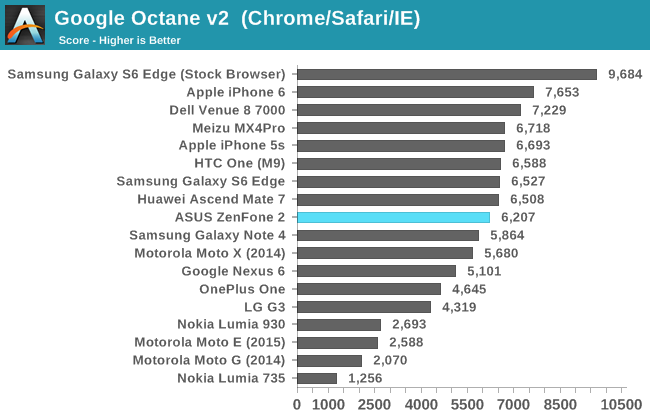
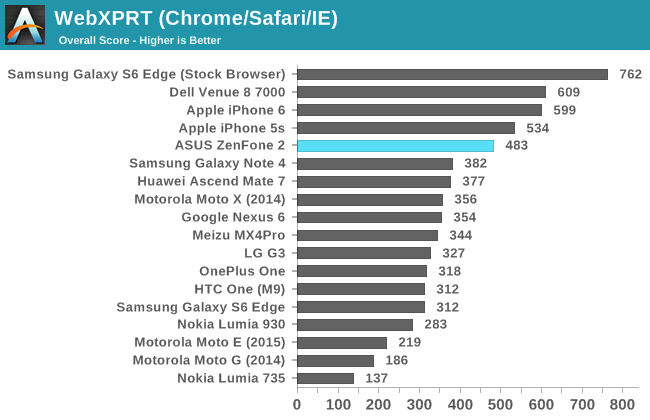
In our web browsing tests the ZenFone 2 performs very well. In the case of Kraken, it does roughly as well as the Venue 8 7000 which uses the same Z3580 SoC. Performance tends to fall behind the Venue 8 in our longer tests like Octane and WebXPRT. I don't have the Venue 8 anymore, but it's a safe bet that this is due to the larger aluminum chassis of the Venue 8 being able to manage heat better in order to keep the clock speeds on the CPU higher during the course of the test.
While the ZenFone 2 isn't quite as fast as a tablet using the same SoC, it's much faster than most of the other devices that we've tested. In general it ends up being a bit slower than the iPhone 5s and the iPhone 6, and of course it loses to the Galaxy S6 using Samsung's browser by an enormous margin in every case. However, a good portion the phones that sit below it are very expensive flagship phones like the Nexus 6, LG G3, and the Galaxy Note 4 which is very impressive for a $300 smartphone.
The next test is Basemark OS II which tests the performance of a device's CPU, GPU, RAM, and NAND.
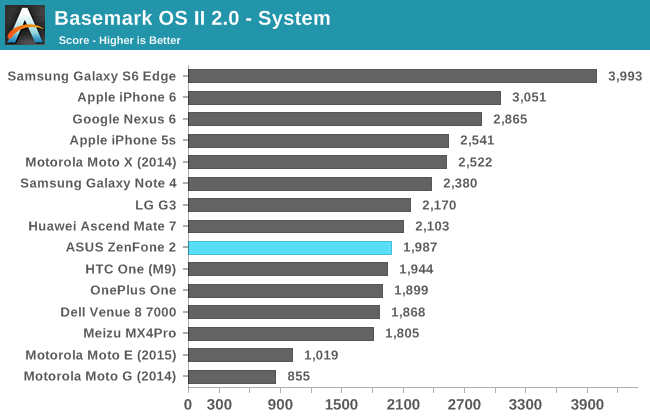
The system sub test performs integer and floating point operations, and also performs some tests like XML parsing. This makes it primarily a test of the device's CPU and RAM. I'm actually somewhat surprised by the ZenFone's performance in this test. By no means is it bad, but I had forgotten that the Venue 8 also struggled to match Snapdragon 801 smartphones in this test.
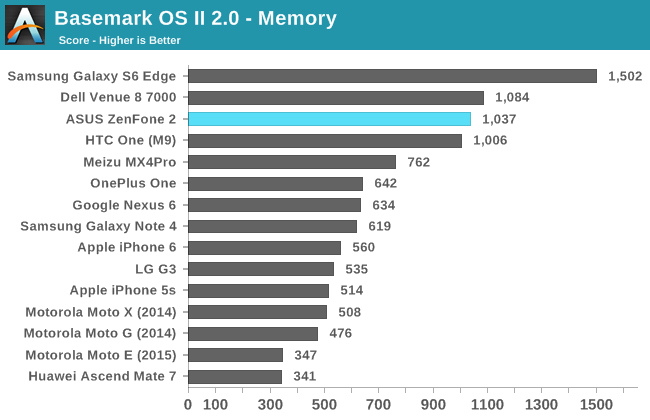
The Basemark OS II memory sub test has a somewhat vague name. While one might expect it to be a test of the device’s RAM, it’s actually a flash storage test. In it we see one of the highest scores of the smartphones we’ve tested, with only the Dell Venue 8 tablet and the Galaxy S6 with its UFS memory achieving higher scores.
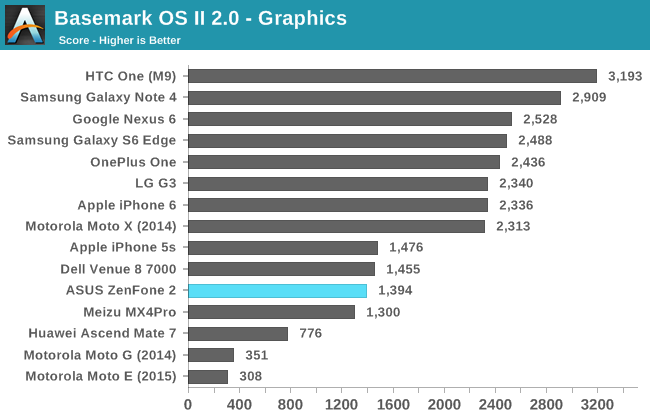
The result in the graphics test is definitely on the lower end of our results, but it’s not unexpected. Both the Venue 8 7000 and the iPhone 5s achieve similar scores, and all three devices use the same G6430 GPU (albeit with lower clock speeds on the iPhone). Even though the ZenFone 2 doesn’t perform as well as the expensive flagship smartphones, it’s far ahead of budget devices like the Moto G. Since both the Z3560 and Z3580 based ZenFone 2 models use the same 533MHz PowerVR G6430 this result should be roughly the same on the $199 model as it is on this $299 model.

The last sub test is the web test. This test focuses on a device’s ability to handle web page rendering, with a focus on HTML5 and CSS rather than Javascript code. In this test we see the ZenFone 2 amongst a large group of devices that includes the HTC One (M9), the Nexus 6, and the Moto X. To see the same level of performance as Snapdragon 805 and 810 devices is very impressive.
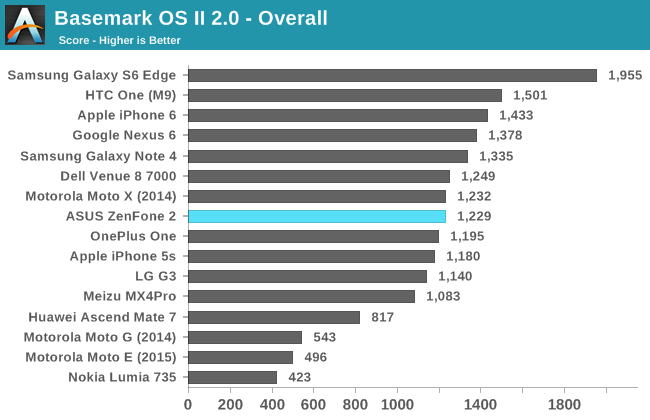
The overall score for BaseMark OS II takes into the account the scores of the various sub tests to generate a final score. In this test we again see the ZenFone 2 around the middle of the pack, with a score that is similar to that of Snapdragon 801 based devices. This is a very good result for a smartphone that costs so little, although the OnePlus One also achieves similar performance at roughly the same price as the $299 model of the ZenFone we are testing.
Our last general performance benchmark is PCMark. This is a relatively new addition to our testing workflow, and it focuses on race to sleep scenarios that reflect the type of usage a device will see in the real world. The tests range from Javascript performance, to playing and seeking in videos, to editing photos.

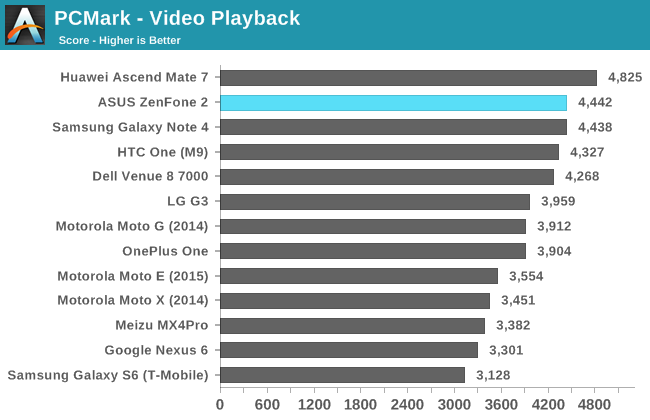
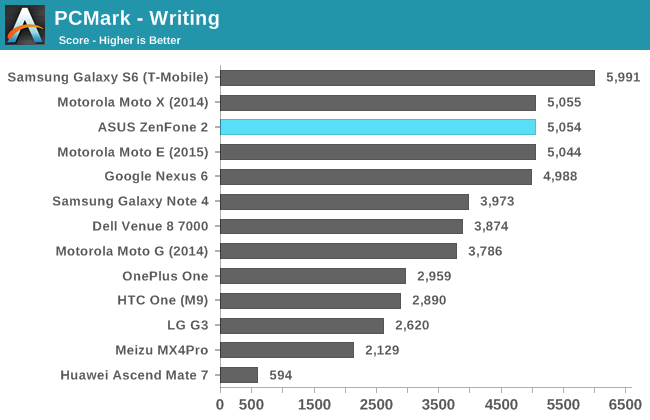
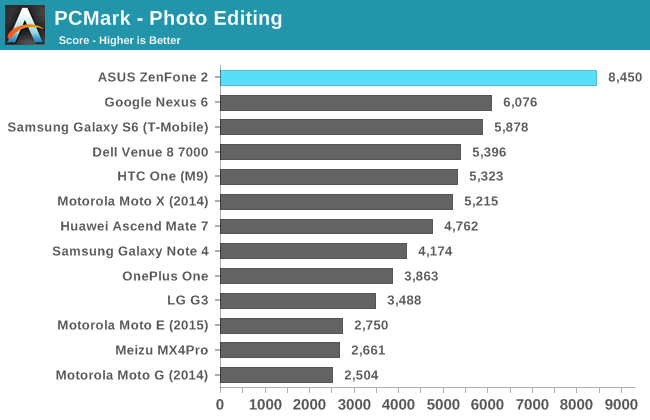
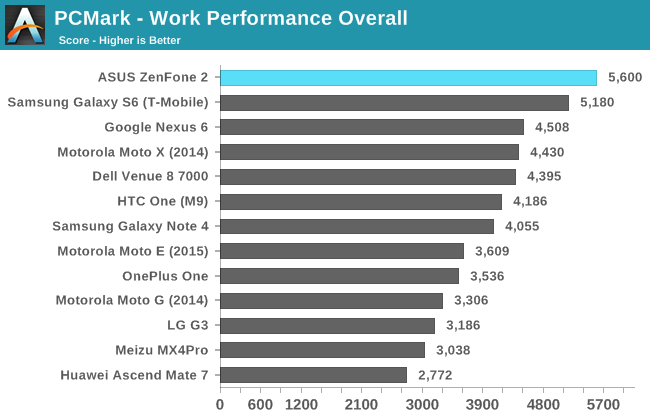
In all of the PCMark sub tests the ZenFone 2 performs extremely well. It’s always at or very close to the top result, and only really loses by a large margin to the Galaxy S6 in the tests that it isn’t right near the top for. The one exception is the photo editing test where it beats every other device by an enormous amount. This score is what carries it to the top position when it comes to the overall score.
I think it’s a bit unfair to say that the ZenFone is the fastest device when it only comes first in a single test, but even without considering the photo editing test it’s clear that the ZenFone 2 offers great performance. Even more amazing is that at times it can trade blows with flagship phones that cost much more than it does. Perhaps due to the fact that it's the only x86 Silvermont-based phone in our benchmarks its relative performance can bounce around versus the competition, but on average it comes rather close to delivering the kind of CPU performance we've seen from the flagship phones over the past year.










147 Comments
View All Comments
speconomist - Wednesday, May 27, 2015 - link
Brandon, could you comment on the speaker?I have read somewhere else that it's not really good, I would welcome your objective comments (or even subjective too).
Brandon Chester - Wednesday, May 27, 2015 - link
Unfortunately I don't have any means of objectively evaluating the speaker which is why I didn't really comment on it. It doesn't sound any worse than the speaker on the iPhone 6 or Galaxy S6 really, but it's definitely not BoomSound, and it's not as good as you'd expect considering the speaker grille is so large.speconomist - Wednesday, May 27, 2015 - link
Thanks, sounds like good enough.thegeneral2010 - Wednesday, May 27, 2015 - link
i heard it was running android 5.0.1 in 32bit and after upgrading to 5.1 its 64bit got activated is this true?ketacdx - Thursday, May 28, 2015 - link
The Zenfone 2 is on 5.0. In CPUZ you can see it is an x86-64bit kernel so it is correctly 64bit by default. Ive read this elsewhere as well but its definitely a 64bit kernel.MeganKnight - Wednesday, May 27, 2015 - link
thats greatseh1984 - Wednesday, May 27, 2015 - link
Is this a review for the 2GB or 4GB model? If the 4GB model, can we get the benchmarks for the 2GB?tipoo - Wednesday, May 27, 2015 - link
They have the 4GB one, as noted in review. The Z3560 has about 80% the CPU performance of the Z3580, and GPU performance is the same between the two.JackF - Wednesday, May 27, 2015 - link
I just got my new ZenFone 2 yesterday. I finally broke down and made the switch from my iPhone5s which I like but wish it had a bigger screen, I doesn't seem as big as I thought it would be - it fits in my front jeans pocket with no problem. After reading the reviews, I am being super careful not to drop it. I routinely drop my iPhone but I have a rubberized type case to cushion the impact.So far I am liking the phone - after using it non-stop all morning (surfing, installing apps, playing games) my battery did get down to 40%. With the same usage tho, My iPhone 5s would probably have been close to zero. I am due for a upgrade in October, so I will see how this goes.
re2onance - Wednesday, May 27, 2015 - link
I ordered one myself and I'm coming from a iPhone 5 which is supposed to have really good web browsing battery performance, so I'm wondering how it will work out. I'm probably going to try to root the phone and run something like greenify to wipe all the crap I don't want on it which comes pre-installed. Hopefully that and updates will improve the battery life on the device, although I'm skeptical.